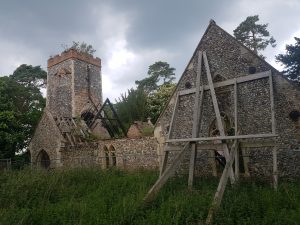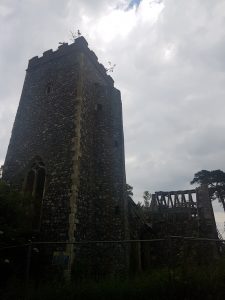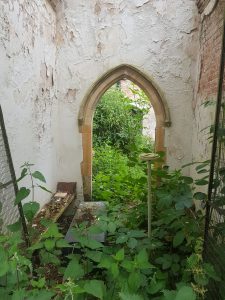Bixley – Saint Wandregesilius Church
Sadly, this church was destroyed by fire on 14 May 2004, even more unfortunate was that it was an arson attack. There has been a church here since Saxon times and it seems enormously sad that a church set fire 15 years ago is still in this state. Realistically not much can now be done other than to knock down most of the nave and just keep the tower.
The tower is perhaps the most interesting part of the church, not just because it’s mostly what is left standing, but also because it’s the oldest remaining part. The tower dates to the fourteenth century whilst most of the rest of the church dates to 1868.
The church was once quite influential and important, and it is the only one in the country which is dedicated to Saint Wandregesilius. And this in itself is a slight mystery, as why does a church in rural Norfolk have a dedication to a Benedictine abbot from France? Wandregesilius, or Vandrille, went on a pilgrimage to Rome and then, to allow himself a religious life, he left his wife. History doesn’t record exactly what she thought of this. He then became a hermit before going to live and work in the Benedictine monastery at Montfaucon. After that he went to St. Ursanne, Jura, which is now in Switzerland, and then became a hermit.
However, back to the question of why the church is dedicated to him. Wandregesilius also founded the monastery of Fontenelle, and it’s that which is one possibility. The Norman conquerors of the area came from Normandy (obviously given the name) and the name and reputation could have come over at that time.
But there’s another solution suggested by a former vicar of the area, AE Alston, who said that the church likely fell into disuse by the late thirteenth century and it was refounded by William de Dunwich. It’s suggested that he possessed a devotion to, or a relic of, Wandregesilius and that is why the church was rededicated to him.
On another matter, once upon a time there was a medieval village in the area, but this has now gone and so have the roads and footpaths which served the church. The church was also once an important pilgrimage centre, so this was a significant location.
The damage to the porch, with the former nave being unreachable as there are barriers up to prevent entry.
Although the church was heavily modernised when it was restored, and indeed rebuilt, in 1868, it hadn’t changed a great deal since then until it was hit by the fire. Back in the sixteenth century there were two bells in the tower, but the mid-nineteenth century there was just one, with an inscription reading:
“I to the church the living call, and to the grave summons us all”.
Very cheery.
It seems that the oak rood-screen survived the 1868 restoration, although I assume that it was either missing before the fire or destroyed during it. The register of burials, marriages and funerals was reported to still exist in 1900, with the book dating back to the seventeenth century and it contained the baptisms since 1575, the marriages to 1563 and the burials to 1593. I shall try and locate where that book is now…..
For anyone who wants a list of rectors of the church (and I’m not expecting this to hit the tens of millions if I’m being honest) then they’re here.



